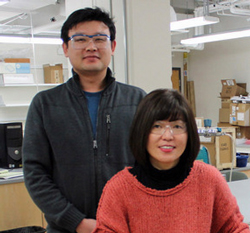In a study published this week in Nature Chemistry, University of Wisconsin-Madison chemistry Professor Kyoung-Shin Choi and postdoctoral researcher Hyun Gil Cha discussed their research to split water into hydrogen, a clean fuel, and oxygen using photoelectrochemical solar cells (PECs).
They developed a novel PEC setup with a new anode reaction. This anode reaction requires less energy and is faster than water oxidation while producing an industrially important chemical product. The anode reaction they employed in their study is the oxidation of 5-hydroxymethylfurfural (HMF) to 2,5-furandicarboxylic acid (FDCA). HMF is a key intermediate in biomass conversion that can be derived from cellulose — a type of cheap and abundant plant matter. FDCA is an important molecule for the production of polymers.
“When we first started this study, we were not sure whether our approach could be really feasible,” Choi says. “However, since we knew that the impact of the study could be high when successful, we decided to invest our time and effort on this new research project at the interface of biomass conversion and solar energy conversion.”
Read more from UMW.


